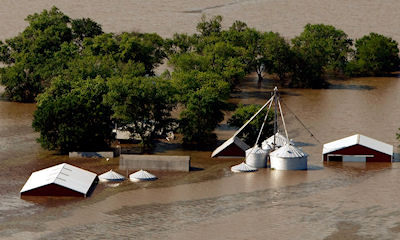
"Maybe it's the timing or maybe it's because there's no crop in the field, but I've never seen so much water," says Christian County farmer Penny Bliler.
Bliler is still in awe over what she and others in her area witnessed over the past week: Closed roads, flooded fields, evacuated homes and a crested river that seemed to overflow in an instant. According to the National Weather Service Advanced Hydrologic Prediction Service, the Sangamon River at Riverton, Ill., reached 29.9 feet on New Year's Eve. For the Sangamon River, moderate flooding is 26 feet and major flood stage is 29 feet.

Volunteers placed thousands of sand bags in communities such as Evansville (pictured) and Prairie Du Rocher. Gov. Bruce Rauner visited these two towns, along with several others in the area, over the holiday weekend.
Jim Angel, state climatologist with the Illinois State Water Survey, reports everything was OK until right after Christmas. "We had an average December, nothing too exciting. Then, a significant low pressure system brought rain across a large section of central and southern Illinois."
That slow-moving system brought heavy rains in waves over two to three days. Angel reports many areas had 5 to 8 inches of rain, but hot spots east of St. Louis and along the Mississippi River got 6 to 10 inches.
Angel summarizes: "We had too much rain, in too little time, with soil moisture to begin with." He also notes that this type of storm system is more likely to occur in March or April. Normally in Illinois, December and January storm systems don't carry that much moisture – or severe weather, like the tornadoes that were spotted across parts of the state just before Christmas.
Unfortunately for many counties across southern Illinois, Christmas was more wet than white.
According to Illinois Farm Bureau President Richard Guebert, Jr., parts of Randolph County were hit with a little over 8 and a half inches of rain. After that, "the river just jumped up." Guebert noted it was the fastest river rise in years. Volunteers placed thousands of sand bags in communities such as Evansville and Prairie Du Rocher. Gov. Bruce Rauner visited these two towns, along with several others in the area, over the holiday weekend.
Rauner has declared a state of emergency for 12 Illinois counties, including Alexander, Calhoun, Christian, Clinton, Douglas, Jackson, Jersey, Madison, Monroe, Morgan, Randolph and St. Clair.
Farmers and elevators also worked quickly to move grain out of bottom ground storage. Carl Tebbe, general manager with Gateway FS, said they opened one location on Dec. 27. They received calls from concerned farmers who knew the rivers would be high, flooding would be possible and grain bins could be compromised.
Related: Flooding causes headache for farmers in Midwest
Tebbe said his team worked extra hours from Dec. 28 until New Year's Eve in order to accommodate customers who needed to move grain out of areas threatened by flood waters. At times, the lines were 20 trucks deep. Farmers who had bins on high ground volunteered their trucks to help other farmers out.
"It was a very stressful time, but the spirit of cooperation was tremendous to see," Tebbe adds.
"I give a hats off to the outpouring of generosity and volunteerism to help neighbors. Whether it was moving grain, helping people move out of their homes or providing food for volunteers," Guebert says.
About the Author(s)
You May Also Like




